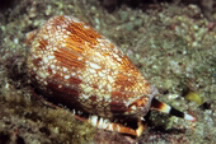FOR IMMEDIATE RELEASE
ACS News Service Weekly PressPac: October 27, 2010
The secret behind the cone snail venom pump
“Proteomic interrogation of venom delivery in marine cone snails – Novel insights into the role of the venom bulb”
Journal of Proteome Research
Scientists have discovered the secret of how an amazing sea snail injects its venom after shooting a harpoon-like tooth into its prey — or some unlucky swimmer — at jetliner speeds. The creatures, called cone snails, use a highly specialized structure that instantly pumps the paralyzing venom through the tooth and into its target. Their study appears in ACS’ monthly Journal of Proteome Research.
Helena Safavi-Hemami, Anthony Purcell and colleagues note that cone snails live mainly in the shallows of the world’s tropical oceans. Prized by sea-shell collectors for their beautiful shells, the snails are up to 9 inches long. Their mouths have a blow-gun-like structure that shoots a barbed dart-like “tooth” at about 400 miles per hour. The tooth injects venom into fish, worms, or other prey. The snails occasionally sting swimmers, causing pain and sometimes death. They can reload the shooter with additional harpoons. The venom is produced in the venom duct, a long tube attached to the harpoon on one end and to the venom bulb in the snail’s mouth.
The scientists’ analysis of proteins in venom bulbs found high concentrations of arginine kinase, a protein that enables squid and scallops to swim away from danger with extreme speed. Its abundance in the bulb suggests that arginine kinase enables the venom bulb to undergo rapid, repeated contractions to quickly force the venom through the venom duct to the harpoon and into the prey, the scientists say. The scientists also identified specialized muscles in the venom bulb that appear to aid in this process.
![]()

Contact
Science Inquiries: Michael Woods, Editor, 202-872-6293
General Inquiries: Michael Bernstein, 202-872-6042


